Today I am going to present two techniques, one offensive and one defensive. The first is how to shim a door using the ol’ “credit card trick.” The second is how to protect your doors from being shimmed.
I posted this article in April of last year. This was already a rock-solid security article. I’ve given it an overhaul and added a bunch of information. It also coincides nicely with a new article coming out Monday. Enjoy!
This post contains affiliate links.
Moral Justification for Lock Defeat Techniques
Since this is the first article here where I am presenting some lock-defeat technique, I’m going to lead off with something of a disclaimer. Some of you may be wondering “why would you teach people to defeat locks?” Simple: if you do not understand how they can be defeated, you cannot mitigate these defeats. It is literally as simple as that.
But also, just so it’s said: never perform any lock bypass/defeat/picking techniques on any lock that you do not own or have explicit permission to access! Breaking into someone elses’ home or business is a serious crime. Obviously I do not condone such activity.
Shimming or the “Credit Card Trick”
The “credit card trick” – more appropriately known as shimming the latch – is extremely prolific. It’s so prolific it even has a nickname. You’ve probably seen examples of it in movies and on television. You may have seen it done, and you may have done it yourself. It is so prolific because so much door hardware is susceptible to it. Few people actually know why and how it works. There are two facts you should know in order to understand how this technique works, and when it won’t. There are a couple of contraindications for this technique that yous should be aware of.
- This technique will not get you through a door with a locked deadbolt. A piece of plastic applying force in a perpendicular direction will not disengage the deadbolt. This technique is useful only for doors secured only with a locking knob set or lever set.
- This technique does not work on doors that open outward. Generally this technique is reserved for inward-opening doors, like most of the exterior doors on your home. In a future post I will talk about a very similar technique for outward-opening doors.
With that out of the way, let’s talk about why this works. The short “why” answer is that the door was either installed incorrectly, or is incorrectly adjusted. The long answer is…well, longer.
The Vulnerability Behind the Technique
Locking knobs and levers rely on a spring-loaded latch to keep the door locked. You probably don’t think much about this latch until you can’t get into your door, but it’s what’s doing the work. The latch is rounded on one side and flat on the other. The rounded surface is what allows you to slam the door. The rounded portion strikes the strike plate (photo further down) which pushes the latch back into the door, allowing it to close.
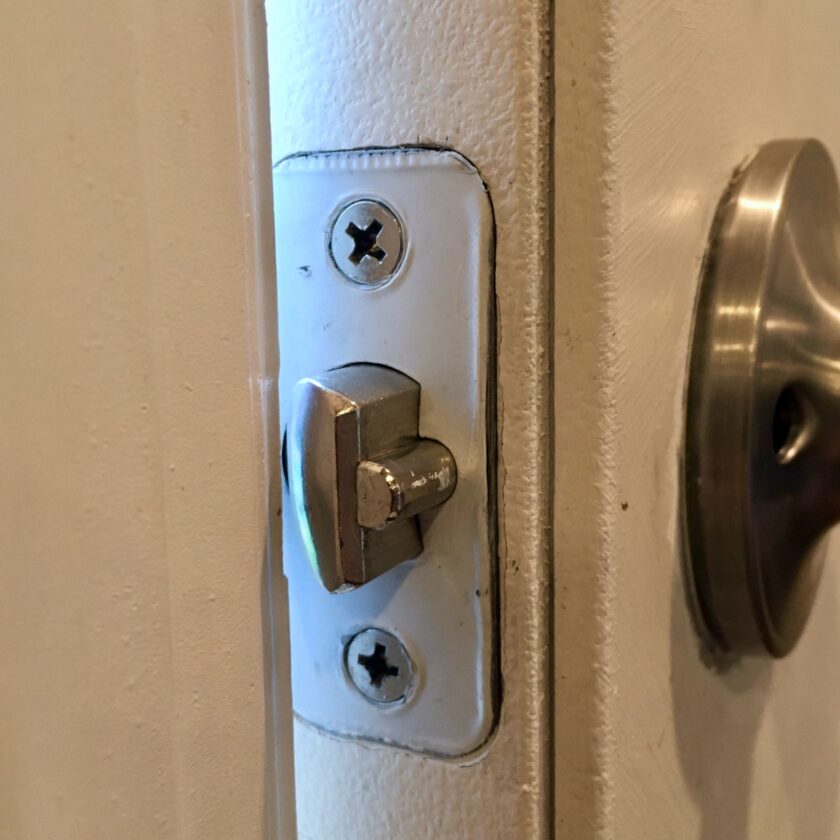
The flat, back side of the latch is a little more complicated. Along this flat surface is another, separate part that moves independently of the latch. It is called the “dead latch.” If you mess around with it you’ll learn a couple of things. First, if the dead-latch is depressed the latch can’t be pushed back into the door. The latch becomes “dead.” If the dead-latch is extended the latch becomes “live” meaning it can be pushed back into the door.
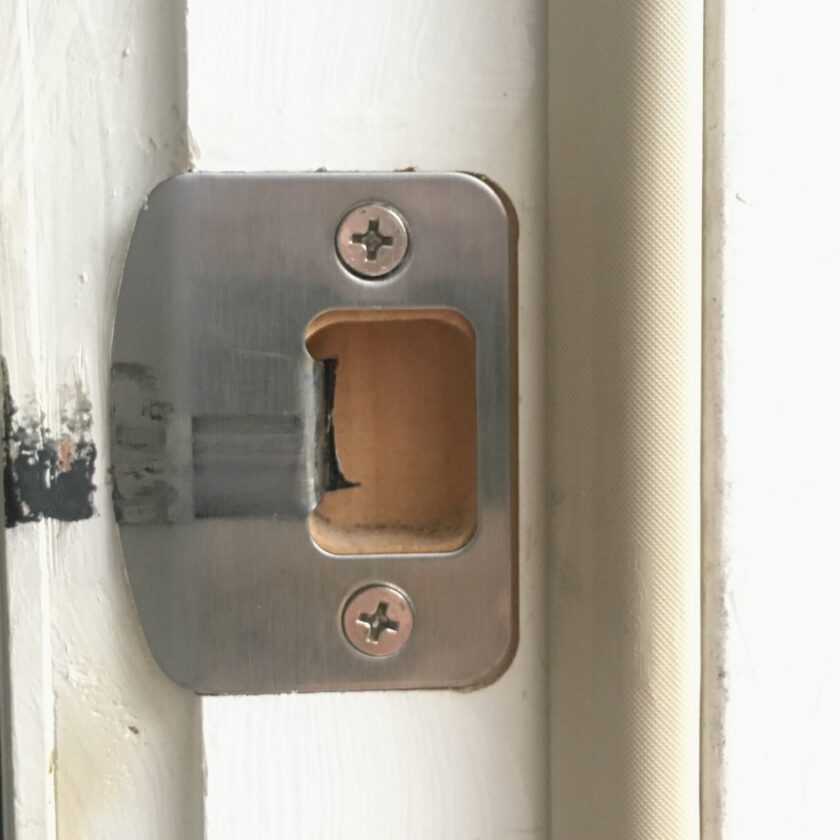
Your door’s latch is designed so that when your door is closed, the strike plate (the metal plate on your door jamb that interacts with the latch) keeps the dead-latch depressed. If all of this works correctly, your door is safe from the “credit card trick” because the latch can’t be depressed.
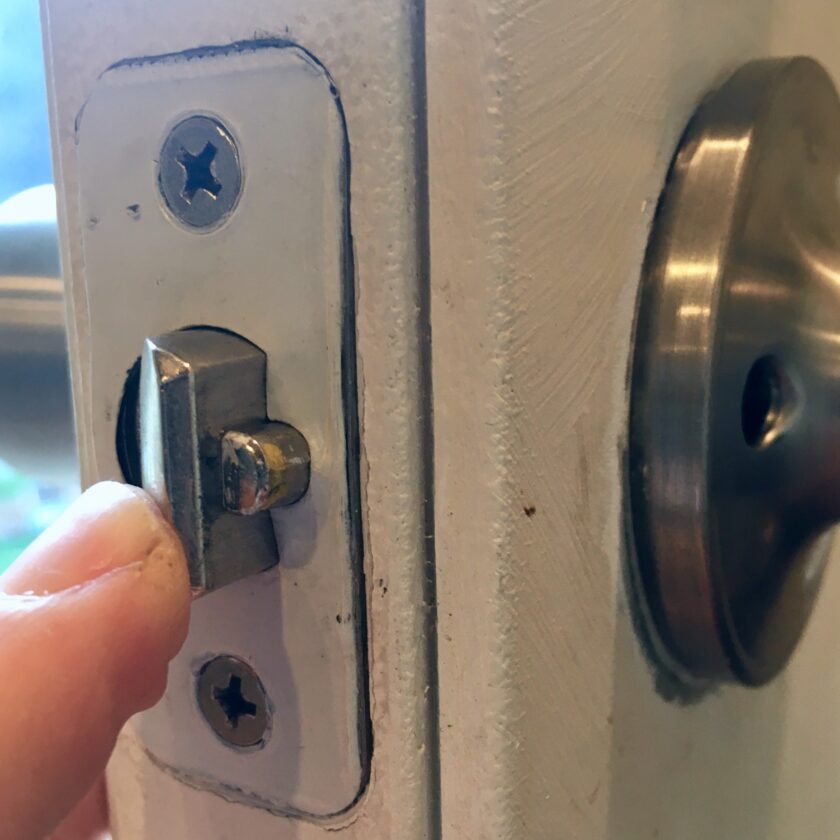
So what makes the credit card trick work? The thing is, most strike plates don’t prevent that little latch from extending. Let’s take another look at what I mean. Below are three photographs. The first is a latch and dead latch, both fully extended. I have placed some yellow paint on the end of the dead latch so we can tell if it seats correctly, or falls into the strike plate.
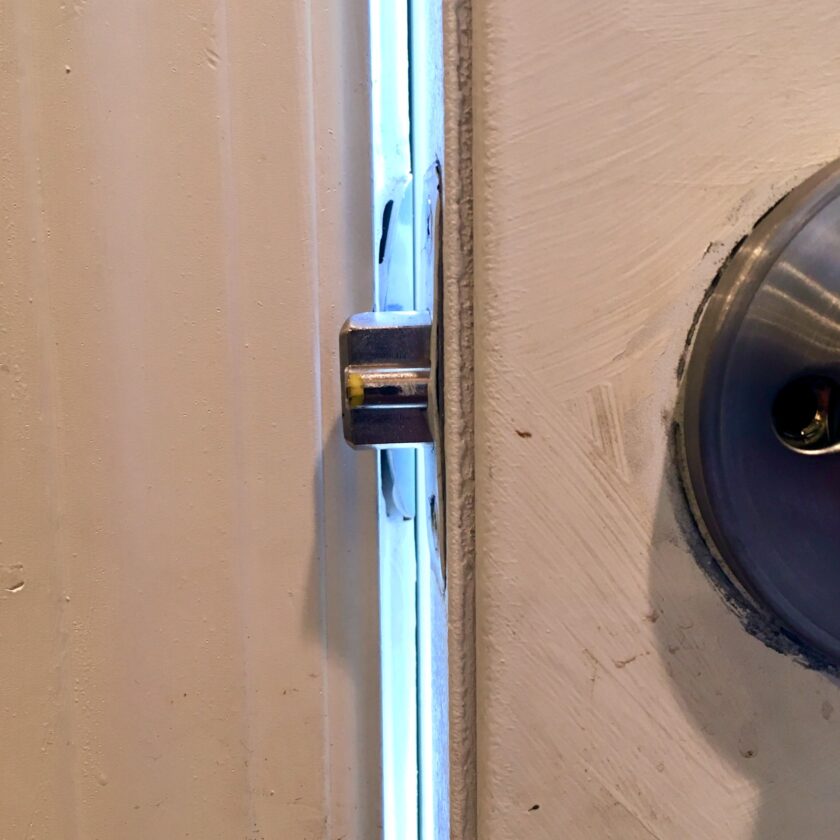
The next photo (below) shows the dead latch after I have closed the door normally. The dead latch is depressed (not extended) and is currently functioning correctly. We would not be able to shim this door at this time. The latch is “dead” and cannot be pushed back into the door.
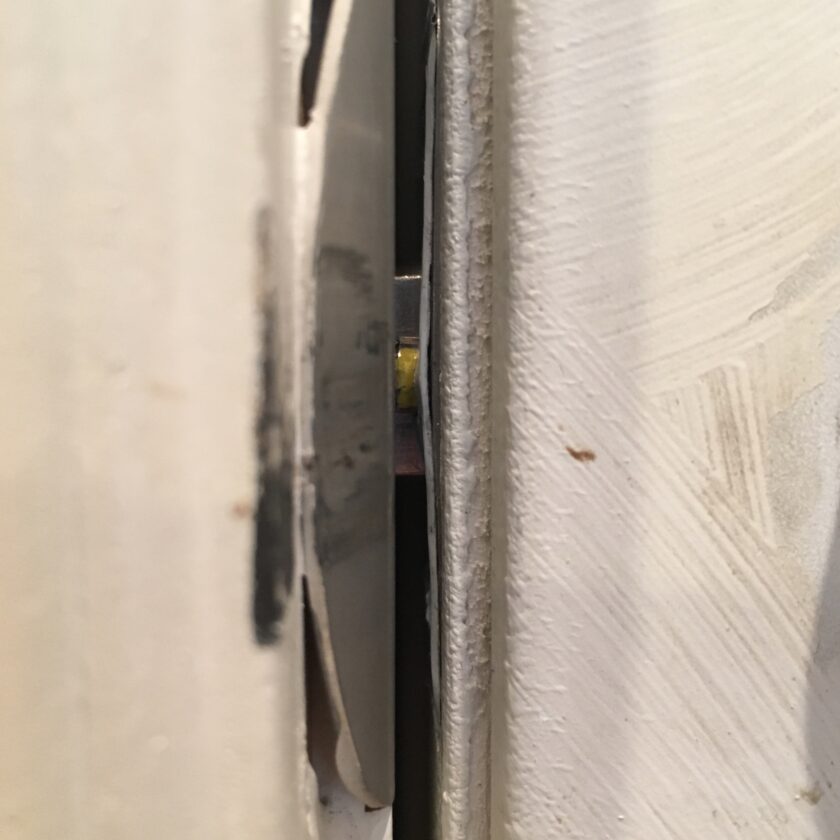
A firm tug on the door from the outside is enough to allow the dead latch to fall into the strike plate. At this point the dead latch has been deactivated and the latch is once again “live.” This latch is ready to be shimmed.
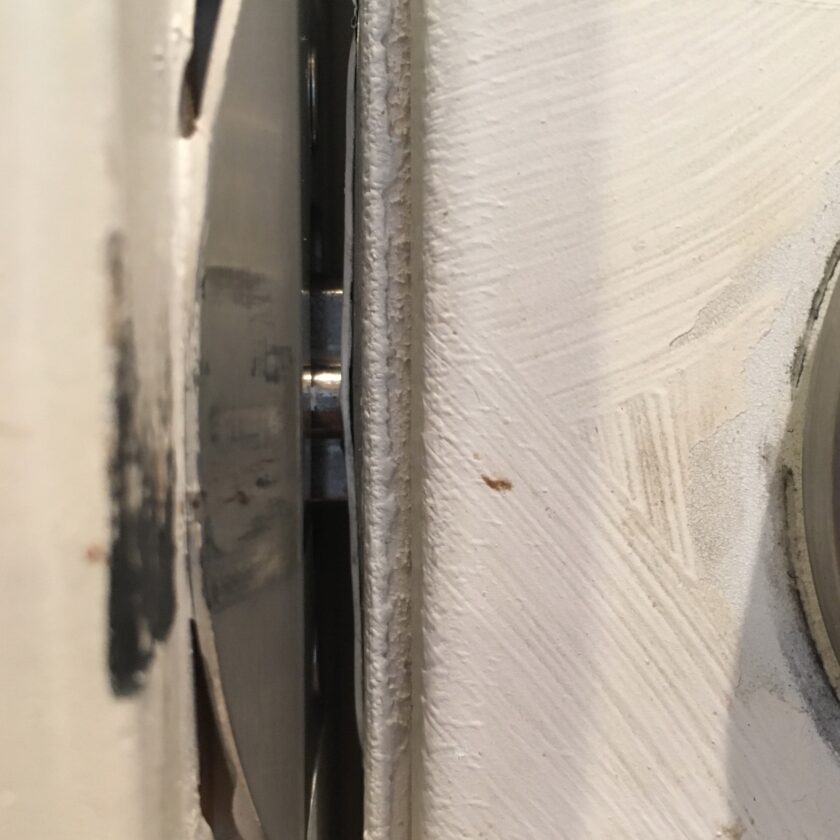
A shim is just a thin piece of material that is introduced between the latch and strike plate. Because the latch is live, it can be pushed back by the shim, retracting the latch without turning the knob.
Important Note
In the photos above I am demonstrating from the interior of the door. If you are attempting to shim this door, you will not be able to see this process happen because you will be on the other side of the door. You will not be able to see the gap between the door and the jamb. You will have to rely on other clues to know that the latch is not dead. Namely, you may hear it “click” into place when you tug on the door. Some homeowners will take this step for you.
Here is a good example. Many years ago, before I knew anything about locks, I lived in a condo on the beach. Every morning when I would leave for work I would lock my door knob from the inside, then pull the door shut (the condo did not have a deadbolt). I would hear an audible “click” as the latch fell into the strike plate. Not knowing any better, I pulled the door snugly until I heard the second “click” of the dead latch falling into the strike. I thought I was doing a good thing; little did I know I was defeating much of the (admittedly minimal) security of my door’s lock.
But…why?
Why would lock manufacturers and builders make your securing dependent on such an easily bypassed mechanism? They don’t do it on purpose but there are a lot of potential causes for this vulnerability. First, your door and lock might have been installed incorrectly. Carpenters aren’t locksmiths. When a house is constructed locks are normally installed by the general contractor who, in all likelihood, doesn’t know a whole heck of a lot about locks. Same deal if locks have been replaced or upgraded by previous owners of your home. Who knows what that homeowner might’ve done.
Even if the lock was installed perfectly, most doors are out of adjustment within just a few months. This happens because of settling, shoddy installation, cheap components, swelling and shrinking of the door jamb with changing weather, or some combination thereof. Worse, there is usually soft, pliable weather stripping around the door. If you can pull the door knob from the exterior and compress the weather stripping, there is a very good chance you can get that dead-latch to fall into place.
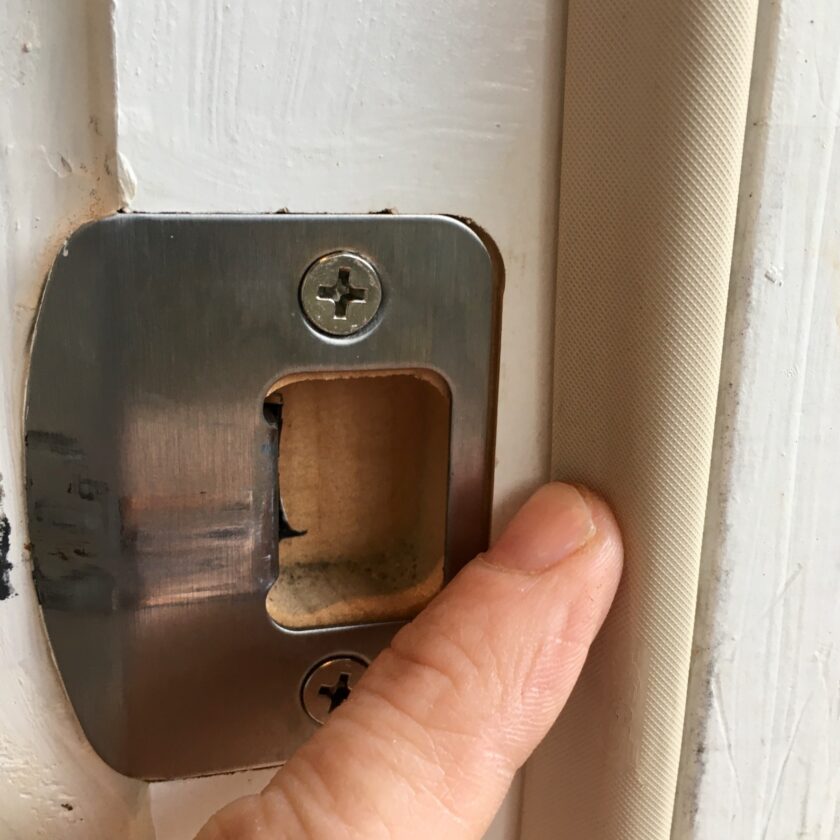
Whatever the reason, this is a dangerous vulnerability. What I am revealing here is nothing that hasn’t been revealed in books, YouTube videos, podcasts, and blog posts long before this one. The point: a lot of people know about this. The information is widely available. The necessary tools can often be quickly fabricated out of garbage. What is less talked about is how to correct such a vulnerability. Let’s look at the technique, then we’ll look at the fix.
How To Shim a Door: Tools
You only need one piece of equipment to pull of this technique (assuming it will work in your situation). That piece of equipment is a somewhat tough, yet flexible piece of plastic. Despite being called the “credit card trick” don’t use your credit card.
The best thing is shim material like that sold by Sparrows Lock Picks. The “Quick Shims” sold by Sparrows come in two thicknesses. They are large enough to do some real work. They are also flexible enough to get around even deep door jambs. Obviously the thinner material is more flexible, and the thicker material is more rigid.
I have found that gift cards – like the Starbucks card in some of the pictures – are usually an acceptable substitute. Gift cards are rather small, limiting your range of motion. Once you have the card deep enough to move the latch you don’t have much to hold on to. Gift cards (or hotel keys) are also somewhat thick, requiring a generous space between door and jamb. Thickness also makes the more rigid and less flexible. You also risk breaking them and getting them stuck in the door.
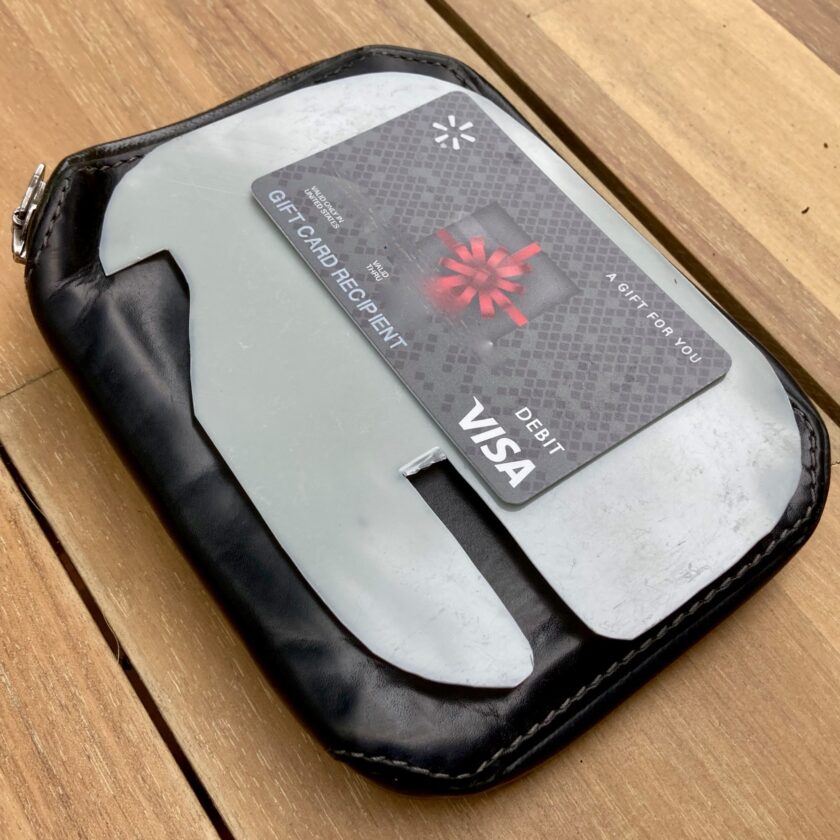
Still, they can work sometimes. Gift cards and hotel keys also have one major advantage: they aren’t lock bypass tools. Even if your wallet gets searched, what do you have to hid? A used-up Starbucks gift card? The hotel key from your last work trip? Who cares? If you live in a place where lockpicks are illegal to carry, this is a serious consideration.
Hereafter I will refer to whatever you use as the “shim.” Regardless of what you use, I recommend rounding off the corners. Material that is rigid enough to shim the latch can also damage weather stripping. You don’t want to damage your own weather stripping in practice. Nor do you want your material getting caught up on weather stripping, potentially fouling your attempt. Really thick, sharp shims will even dig into soft wood.
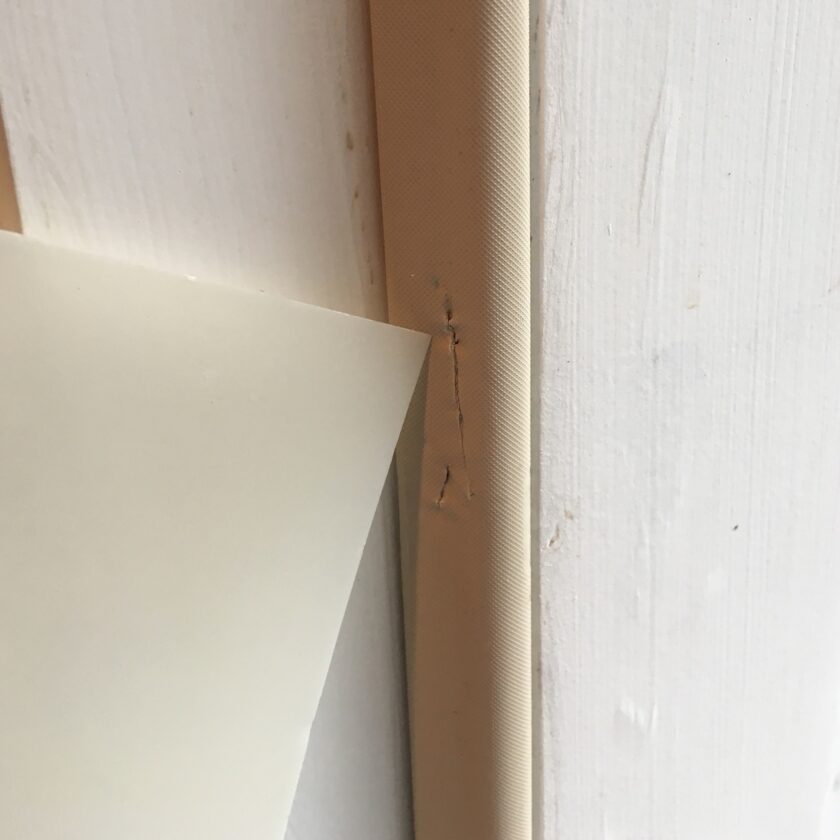
How to Shim a Door: The Recce
Next, before your begin shimming the latch, you need to ascertain that either there is no deadbolt present or the deadbolt is not locked. If there is no deadbolt, you’re good to go. If there is, you can see if the deadbolt is engaged or not by using your shim. People often take security shortcuts for the sake of convenience, and deadbolts sometimes don’t get locked. To check, simply insert your shim between the door and jamb at the height of the deadbolt. If it slips through easily the deadbolt is not locked. When it runs into the deadbolt…well, there’s your answer, pal.
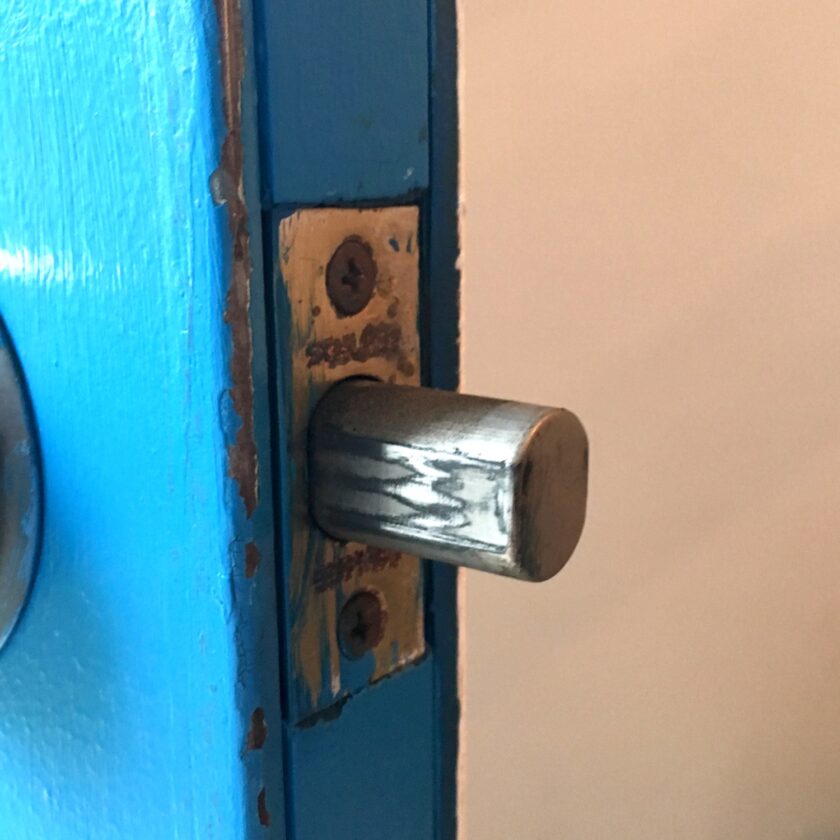
If the deadbolt is not latched give the door a pull.This technique will probably work if there is a lot of play in the door. If it is tight, see if you hear the tell-tale “click” of the deadlatch dropping. That “click” indicates this technique will probably be successful. Absence of the click does NOT mean the technique won’t work. It still might – the dead-latch might already be set.
As long as the deadbolt is not locked the technique may work. Now is the time to find out.
How to Shim a Door: The Technique
Once you are sure the deadbolt is not locked, you can begin. First, pull the door toward you as hard as you can. This gives the best possible chance that the dead-latch will extend fully. Listen carefully for the dead latch to fall into the strike plate. If you don’t hear it this could simply mean that the dead latch is already set. Insert your shim between the door and the jamb, just above the knob’s latch. Insert it at an angle as shown in the photo below.
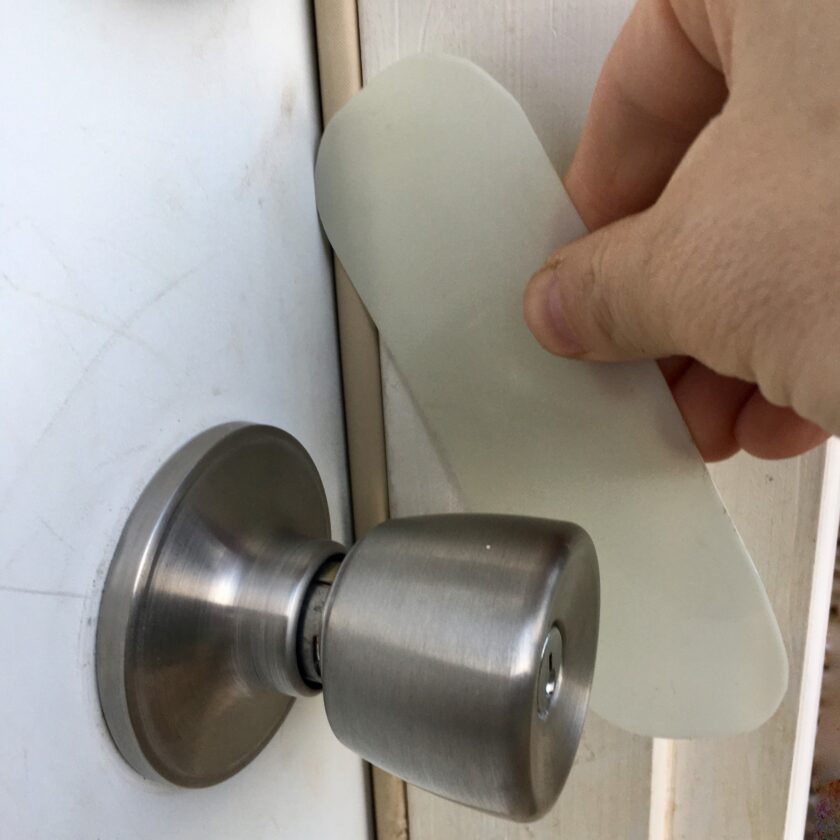
Coming in at an angle like this helps the card to get between the strike plate and the latch. You introduce the shim material a little at a time. Keep applying downward and inward pressure on the card. DO NOT come straight in toward the latch.
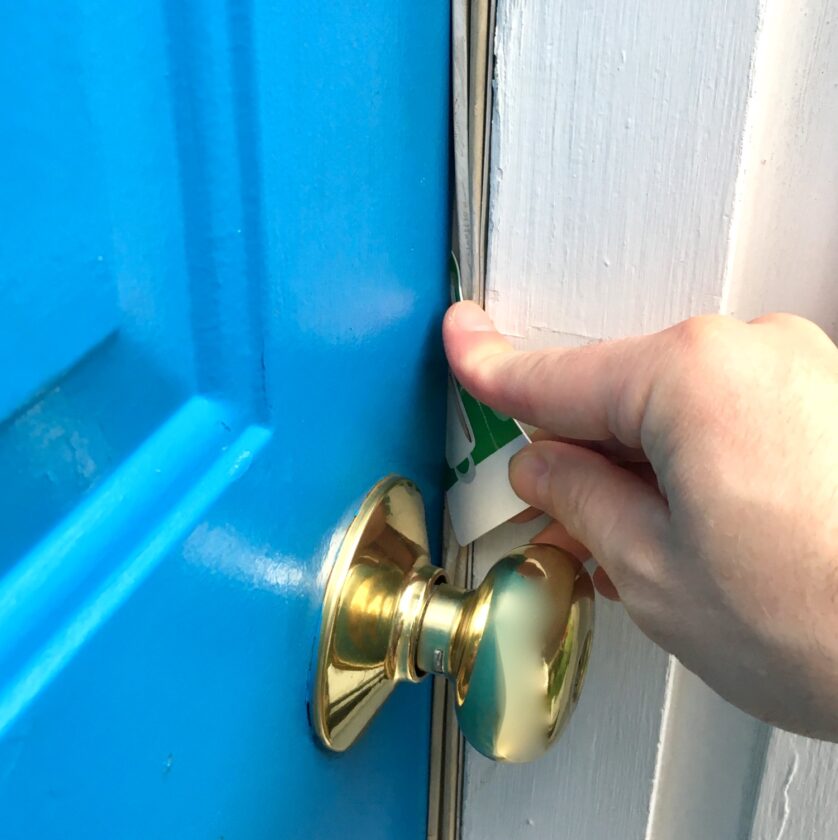
At the same time, grasp the door knob and “wiggle” the rapidly in an inward/outward motion. It is possible for the latch to bind against the strike plate; wiggling the door can take some pressure of the latch and allow the shim to slip in.
Once the shim is inserted deeply enough it will separate the bolt from the strike face and the door will open. Voila! If the door doesn’t open after a few second, check your technique and try it again. If it still doesn’t open there is one other thing you can try. You can come in from below, attacking the bottom of the latch. Use the exact same technique, but coming up from below. Sometimes your shim material will get caught on a screw head or other obstruction, preventing it from reaching the actual latch. Coming from below can sometimes bypass the obstruction.
If it still doesn’t open…it’s probably not going to.
Defense
Defending against this technique is fairly easy: have a correctly installed deadbolt on all your exterior doors. Ensure that your deadbolt is used at all times. Some of you may be unable to install a deadbolt. While deadbolts can cost as little as $12, you do need some tools to install one. That may be cost prohibitive for some people. You may also live in an apartment where the installation of a deadbolt is not allowed. I have lived in such places, (though I hope never to again). So, bottom line: deadbolt if at all possible.
If installing a deadbolt is not possible, adjust the door so that it cannot close “too far.” If it allows the dead latch to fall into the strike plate it needs adjusting. The simplest way I have found to accomplish this is by adding something to the door jamb to limit how far it can close.
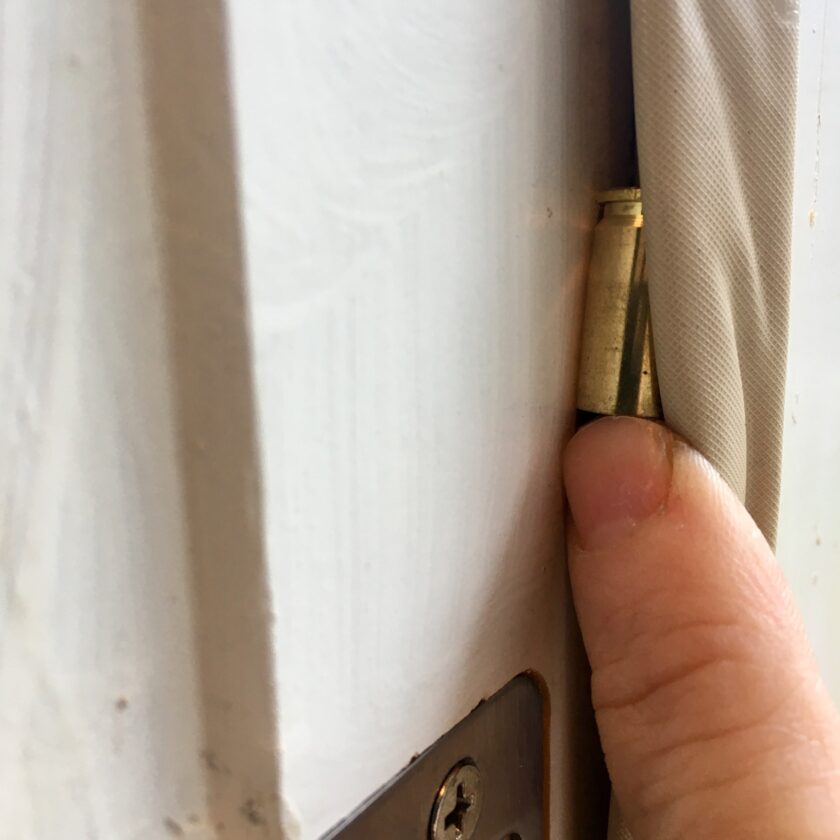
You are limited only by your imagination. If you have the appropriate tools you could rip down narrow strips of wood and glue it to the jamb once the sufficient width has been found. A wooden, #2 pencil placed against the jam might prevent the door from over-closing. Believe it or not, on at least three separate doors I have been able to correct the issue by placing a couple of pieces of 9mm brass into the weather stripping. You may have to play with this; 9mm brass may be too large or small, preventing the door from closing sufficiently, or still allowing it to close too far.
Closing Thoughts
This is a pretty awesome technique. It works way, way more often than it should. Even if there’s a nice deadbolt on the door, don’t count this technique out. Convenience often wins out over security. For your own security, make no mistake: this is a serious vulnerability. Test your door. If your dead latch falls into the strike and you don’t have a deadbolt, fix this issue ASAP. Preferably, fix it buy buying a high-quality deadbolt.






2 thoughts on “How to Shim a Door…and Protect Yours”
Comments are closed.